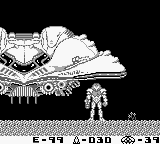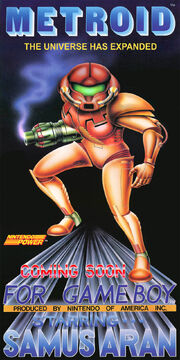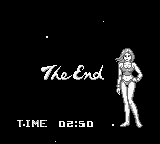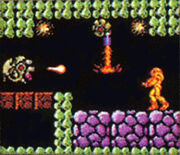| This article is written from the Real Life point of view |
Metroid II: Return of Samus (メトロイドII RETURN OF SAMUS Metoroido Tsū Ritān Obu Samusu) is the sequel to Metroid, the second game in the Metroid series, and the only one to appear on the Game Boy. It is about Samus Aran's mission to exterminate the Metroids on their home planet, SR388. Although it is the second release in the series, chronologically it takes place after Metroid Prime 3: Corruption and before Super Metroid.
Plot

Samus Aran's gunship as seen in Metroid II: Return of Samus.
After the events of Metroid: Zero Mission and the Metroid Prime series, where Samus Aran put a stop to numerous Space Pirate operations intending to use the newly discovered Metroids for evil purposes and defeated a being born from a heavily mutated Metroid, the Galactic Federation called its members to an urgent conference. After serious consideration, they reached a conclusion: the extremely dangerous Metroids must be rendered extinct, which would ensure the creatures would never again give rise to chaos similar to those seen in the past. The Federation first sent a research team to the Metroid homeworld, SR388, to investigate the presence of any remaining Metroids. When contact with the research team's base and ship were lost, two additional teams were sent, first a search and rescue party then a Galactic Federation Special Squadron, but one after the other, they too were not heard from again.
Realizing the threat that the species still pose, the Galactic Federation sends Samus Aran on a mission to land on SR388 and destroy all Metroid organisms. With her experience in past events with Metroids, the Galactic Federation is certain she will succeed.
Arriving, Samus lands her gunship near the only entrance to the planet's underground areas. She exits her ship and begins the difficult trek through the planet's dark network of caves and ruins.[1]

The Queen Metroid as seen in Metroid II: Return of Samus.
One by one, Samus hunts down and destroys each Metroid on the planet. As she does so, she takes note of the steady mutation that each goes through. She discovers Metroids in stages of growth from the small jellyfish-like state into massive, hovering lizard-like beasts. As Samus travels deeper and deeper, the planet rumbles at intervals and the acid drains, revealing a massive complex of Chozo ruins. Finally, after several harrowing battles with massive Omega Metroids, she uncovers a small ruined royal palace with mature Metroids floating in the breeze. With their destruction, only one Metroid remains — the massive and deadly Queen Metroid. Samus fights a final battle before finally defeating the slithering monster, and as it crumbles to dust the final volcanic eruption sputters out. Returning to her gunship, Samus comes across a Metroid egg. The egg hatches and before her eyes a small Metroid hatchling floats out of the broken shell and begins to chirp at her. The Metroid, upon seeing Samus, believes her to be its mother. Samus, despite being ordered to exterminate the Metroids, spares its life. The two continue towards the surface, and the Metroid hatchling helps Samus escape the caverns. Samus and the young Metroid board the gunship, ending the game.
On board the gunship, Samus places the Metroid in a container so that it cannot cause any harm to the ship. Noting the immense scientific opportunity that the captured hatchling poses, she departs SR388 and heads to Ceres Space Colony to deliver her groundbreaking find — a domesticated, baby Metroid.
The events of Super Metroid follow almost immediately afterward.
Gameplay
Gameplay is similar to other 2D Metroid games. However, Metroid II is more straightforward in the sense that advancement through the levels is not strictly controlled by item acquisition as in the other games, but by killing a certain number of Metroids in the area. Once they are destroyed, an earthquake occurs and SR388's Acid levels decrease, allowing Samus to travel deeper through its maze-like tunnels.
Like Metroid, Metroid II contains no in-game map. Where it differs, however, is the map being made of multiple, discontinuous sections that produce a "scene fade" effect when crossing (similar to riding elevators in other games). These sections do not fit together in a flat, 2-D pattern, making the 2-D space of the map "twisted". It is the first game of the Metroid series to do so. Metroid Fusion and Metroid: Zero Mission later use this method, even while retaining an in-game map. Also unique to the game is the Metroid Detector, which displays the number of Metroids left on the planet. It is also the first in the series to utilize Save Stations, located in various points around the planet.
Areas

Note: All names below come from official walkthroughs in Nintendo Power, and are not named ingame.
Items and abilities
Rather than being the first items she finds as in most Metroid games, Samus begins her mission with the Morphing Ball, the Long Beam, and a small number of Missiles. The Ice Beam and Wave Beam return as upgrades, as well as the Bombs, the Varia Suit (known in the game as "Varia" and in the manual as the "Barrier Suit"[2]), the High Jump Boots, and the Screw Attack. In addition, Metroid II introduced new items into the series, some of which have been in almost every game since. The game features two new weapons: the tri-splitting Spazer Laser Beam[3] (identified in-game as the "Spazer"), and the super-powerful Plasma Beam that pierces through enemies. As in Metroid, only one beam can be equipped at a time, though Samus can switch between them by collecting the beam she wants to use again.
The Space Jump also debuts in this game, which allows Samus to spin-jump repeatedly in the air, allowing her to access otherwise unreachable areas. The Screw Attack can be used in conjunction with the Space Jump to shred through almost everything.
New upgrades were given to the Morph Ball. The Spider Ball made its debut in Metroid II and would later appear again in Metroid Prime and subsequent sequels. The Spider Ball allowed Samus to climb any wall or ceiling, unlike its Prime counterpart which only allowed Samus to ride along special "magnetic" rails. The Spring Ball was also introduced, which gives Samus the ability to jump while in Morph Ball form.
List of items in Metroid II: Return of Samus
Metroid lifecycle

The Metroid life cycle.
Metroid II and Metroid Fusion are the only Metroid games that show the assumed natural transformations of the Metroids, but Metroid II remains the only game in which Samus fights every one of them. The life cycle is in the following order:
The more powerful Metroids are found further into the game, with the Queen Metroid being the final boss.
Endings

The best ending, where Samus is not in her Power Suit.
After the credits are displayed at the end of the game, the total time the player took to complete the game will be displayed. During the credits, Samus is shown running on the screen. Depending on the completion time, a certain ending will be achieved, all of which are shown below:
| Under 3 hours | Samus jumps off screen and when she lands, her armor disappears and she will be wearing a bottom and tank top. |
| 3 to 5 hours | Samus jumps off screen and when she lands, she poses in her suit. |
| 5–7 hours | Samus will continue running. |
| 7+ hours | Samus will not run.[1] |
Development
Metroid II marked a "new high point" for handheld game consoles, with graphics that were almost as good as the 8-bit graphics in games for the Nintendo Entertainment System. The game was the first in the series to feature a battery backup to allow players to continue their games from a previously saved point.[4] Metroid II was designed by Nintendo R&D1 and produced by Gunpei Yokoi; they both also worked on the previous Metroid game. Metroid II was released as the second game of the series, but it is chronologically the sixth in the overall story. The game features enhancements from its predecessor that include easier controls which allow Samus to crouch while firing at the same time, and jump while shooting straight down to attack anything below her.[5]
The Game Boy's black and white graphics limited the detail in each area of the game, which forced changes to Samus' appearance, which would later be used for the rest of the series. In the original Metroid on the NES, Samus' suit would change color to show the difference between Samus's Power and Varia Suits. However, without color on the Game Boy, the two suits appeared the same. This forced the developers to create a visual indicator for players to determine which suit Samus was wearing. They updated her Varia Suit, adding round, bulky metal shoulders that have been a part of the suit in every game in the series since then. Even though the game cartridge for Metroid II has six times less memory than its predecessor on the Nintendo Entertainment System, the game allowed players to save their progress for the first time in the series. To save the game, players would step on save modules, which have appeared in every Metroid game since. Metroid II and Metroid Fusion are the only games in the entire series to show the natural life cycle of the Metroids. Because of the Game Boy's small screen, the developers made Samus's model bigger compared to her surroundings, to give more detail in her appearance using limited graphics capabilities. While improving Samus's design, the change also made the environments feel cramped.[5]
Reception
Metroid II is more linear than Metroid, since most areas are blocked off until a certain number of Metroids are killed. It received good reviews when it was released nonetheless — Nintendo Power gave it a 4.5/5 and most gaming magazines and websites have a similar opinion.
In spite of this, some critics and gamers consider it the weakest title of the series, compared to Super Metroid or Metroid Fusion. In retrospect, it is often viewed merely as a connection between the first and third released titles and as an expansion on Metroid morphology. Still, it was later repackaged in a gold colored box along with the official Player's Choice emblem, showing it was well received by many.
Color version
The original version of Metroid II.

Image from the April 1998 issue of Germany's Club Nintendo magazine which unveiled the Game Boy Color. It may or may not have represented work that was in development.
A color version was announced in 1999 shortly after the release of the Game Boy Color. Dan Owsen of Nintendo claimed its color-palette needs were even taken into account in the design of the Game Boy Color hardware.[6] Some pictures were shown but the game never saw the light of day.
Like all original Game Boy games, the Metroid II cartridge is also compatible with the Super Game Boy accessory for the SNES, manually remapping the color scheme to a maximum of four different colors. Additionally, the Game Boy Player accessory for the Nintendo GameCube automatically colorizes the game, but not true full color, as it is still limited to the same colorization techniques of the GBC and GBA.
According to Retro Studios artist, Ben Sprout in 2009:
| “ | I've always thought it’d be awesome to remake Metroid 2. A group of us at Retro even discussed doing it as a side project at one point. Nothing ever came of it, though I still think it’d be fun to remake it as a 3D sidescroller. | „ |

Danny Richardson created concept art of an Omega Metroid that went unused.
Virtual Console
Metroid II was re-released for Nintendo 3DS Virtual Console. Rather than include a new color palette, it instead features the option to turn the screen from black and white to green monochromes, which emulates the Game Boy's monochrome display. In addition to the in-game save feature, it also has a "Restore Point" function, which allows players to save the state of their game.
An earlier digital release was considered alongside other Game Boy titles in a 2006 patent for a Nintendo branded cellular phone.[7]
Trivia

Game logo.
- Oddly enough, Samus encountered a total of only 48 Metroids on SR388, despite it being their homeworld. It is also interesting to note that most of the Metroids resided within the base of SR388, though one would think they would be scattered throughout the volcanic planet.
- Metroid II: Return of Samus is the only game in the Metroid series that does not have a Countdown at some point in the game. Instead, Samus leaves Phase 9 with the baby. Metroid II is also the only Metroid game not to feature any Elevators, Ridley or Space Pirates (Metroid Prime 2: Echoes and Metroid Prime Hunters also lacked Ridley, though Pirates were featured in those games), to never have its music remixed in a future game or feature remixed music (apart from the item acquisition fanfare and Samus Aran's Appearance Fanfare), and until the Nintendo 3DS, was the only Metroid game not playable on a current-gen console in some form, excluding emulators. The second most recent console that was capable of playing it was the Game Boy Advance SP (the GB Micro was only capable of playing Advance games). Metroid II was released for the 3DS Virtual Console on September 28, 2011 in Japan, and November 24th of the same year internationally.
- With a total of 40 boss battles, Metroid II: Return of Samus has the most boss battles in the Metroid series.
- The lack of color in Metroid II had long-term effects on Samus' appearance. In Metroid, the Varia Suit was a different color from the normal Power Suit, but the same shape. In Metroid II, the Varia Suit had to have a different shape to distinguish the Suits because there was no color. Thus, the Varia Suit gained the extra armor plating and bulky, round shoulder pads that have become its most recognizable traits. In addition, rather than Samus' Arm Cannon and Visor changing color when Missiles were activated or deactivated, the end of the Arm Cannon tip moved outward and back to show that the "missile hatch" was open. These graphical changes have been used in all Metroid games since Metroid II, including the remake of the first game, Metroid: Zero Mission. With regards to the Power Suit's appearance, the official in-universe explanation is that the Varia Suit with bulky shoulder pads is a Legendary Power Suit, which Samus receives after losing her original Power Suit when her Gunship crashes.
- The Super Game Boy Player's Guide has suggested color palettes to use throughout the game if playing with a Super Game Boy. It was given out with issues of Nintendo Power around the time of the Super Game Boy's release.
- Certain aspects of this game are similar to the movie Aliens. Both involve the female protagonists (Ellen Ripley/Samus) travelling to the homeworld of the alien specimens (LV-426/SR388) to exterminate them, both depict a final battle with the queen of the creatures (Queen Alien/Queen Metroid), and both depict the female protagonists bonding with a child (in Ripley's case, it is a colonist nicknamed "Newt" while in Samus' case it is the baby).
- The instruction manual of the game notably has several spelling mistakes in the descriptions for the enemies Alpha Metroid, Halzyn and Moheek. Additionally, the instruction manual states that Samus has an Infrared Ray Scope that allows her to see in the dark. This is untrue, however, as there are many occasions where Samus cannot see in the dark, including a pitch-black area in Return of Samus itself. It is possible that it was a scrapped item.
See also

PAL Game Boy Pocket bundle with Metroid II and Wave Race.
- List of creatures in Metroid II: Return of Samus
- List of bosses in Metroid II: Return of Samus
- List of items in Metroid II: Return of Samus
- Metroid II: Return of Samus Image Gallery
References
- ^ (1991) Metroid II: Return of Samus instruction manual. Nintendo of America, Inc., 3–6.
- ^ (1991) Metroid II: Return of Samus instruction manual. Nintendo of America, Inc., 14.
- ^ (1991) Metroid II: Return of Samus - Instruction Booklet, DMG-ME-USA-2. Nintendo of America, Inc., p. 22
- ^ Kent, Steven L. (1994-05-05). Inside Moves. The Seattle Times. Retrieved on 2009-02-19.
- ^ a b The Metroid Retrospective – Part 1. GameTrailers (2007-07-25). Retrieved on 2009-02-19.
- ^ The MDb Interviews Dan Owsen. www.metroid-database.com. Retrieved on 2006-06-29.
- ^ http://www.google.com/patents?id=GBh4AAAAEBAJ&printsec=abstract&zoom=4#v=onepage&q&f=false
Template:R/C Metroid games
